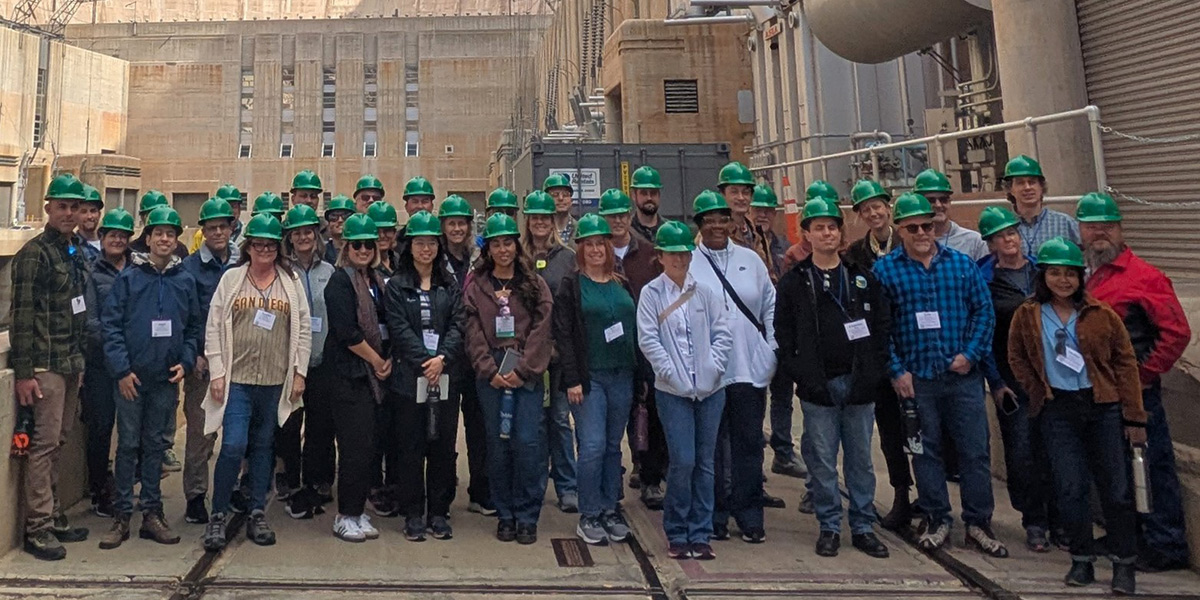Editor’s note: The Water Education Foundation (WEF) hosts an annual Lower Colorado River Tour, sponsored by CAP. During the three-day trip, participants travel from Las Vegas to Yuma, seeing the river and infrastructure first-hand and learning from experts who discuss the challenges that are faced on the river.
Each year, a diverse group of water professionals board a bus to learn about the Lower Colorado River. There are stops at dams and pumping plants, reservoirs and farmlands. Experts share their knowledge and perspective … historic milestones and current challenges.
Most participants are complete strangers at the start of the trip, but along the way, conversations occur, perspectives are shared and relationships are formed.
Central Arizona Project (CAP) previously detailed this trip, so this year I wanted to share three takeaways from this impactful experience.
The infrastructure constructed to manage and transport Colorado River water is amazing.
Our first stop was Hoover Dam, the most well-known dam in the West, and it is incredibly breathtaking. As you stand near its base and look up 726 feet, it’s a nearly 100-year-old feat of engineering that is striking. However, it is not the only amazing infrastructure in the Lower Colorado River Basin.
Mark Wilmer Pumping Plant, the first plant in the CAP system, lifts Colorado River water 810 vertical feet into Buckskin Mountain Tunnel. It’s a fact that is easy to overlook — the pipes are not visible — but the lift is nearly 100 feet higher than the Hoover Dam. It’s no wonder the pumps are 66,000 horsepower!
Hoover Dam also not the oldest dam in the system.
The enormity and the age of the infrastructure requires work from thousands of incredibly talented people. They maintain, operate and repair this aging infrastructure that is critical to all those in the Lower Colorado River basin. It is a path that will continue to require significant resource dedication.
Water people are passionate people and good stewards of this precious resource.
We listened to representatives from agricultural districts, Tribes, water wholesalers, and those dedicated to water in the environment. No matter their perspective, they all were extremely passionate about their work and insistent on responsibly maximizing the use and benefit of Colorado River water.
Las Vegas treats and returns all wastewater to Lake Mead. Farmers utilize technology to reduce water consumption. Agencies encourage conservation through programs like subsidized turf removal. Water rates increase exponentially for those who use excessive amounts. Native plants and animals are being returned to the environment.
No matter what field they represented, passion and responsibility were at the forefront of all those working on water in the West.
Water in the West is complicated and working together is the only way to move forward.
For more than 100 years, water in the West has been a journey of collaboration and compromise. From the 1922 Colorado River Compact to the Drought Contingency Plan Authorization Act and everything in between, the greatest successes have been when collaboration is the strongest.
Brock Reservoir is an example. Water managers came together and showed that collaboration is a powerful strategy to achieve a solution that works for everyone. In this case, it was the collaboration of the Bureau of Reclamation, Southern Nevada Water Authority, Metropolitan Water District of Southern California and CAP. The team funded and constructed Brock Reservoir, the first Colorado River infrastructure project designed solely to conserve water in the Lower Basin.
It hasn’t always easy, and it is not going to become easy anytime soon. However, after experiencing the dedication and passion of those in the Lower Basin, it is a path that we will forge together.
KRA: Public Trust, Partnerships & Leadership
Earning and preserving public trust, building and maintaining partnerships, and providing informed water management leadership


